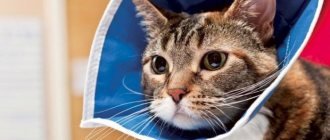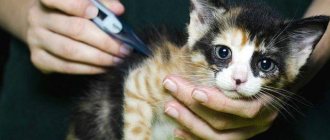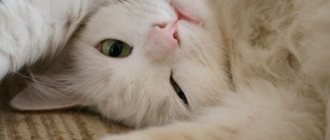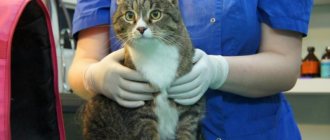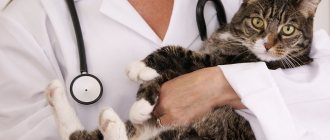If you are about to have your cat sterilized, remember: your attending physician should tell you about post-operative care. First of all, you need to follow his instructions and ask the clinic in as much detail as possible.
Why then is this article needed? The fact is that there are situations when an operated cat in a blanket is simply handed over to the owners without a full consultation. It happens that we’ve discussed everything, but forgot some small detail - but you can’t get through to the doctor because his working hours are over. And finally, some owners want to know in advance what kind of care the cat will need after surgery. Just to assess your strength and plan everything.
Post-operative appointments can vary greatly depending on how the surgery went, what anesthesia was used, and even your surgeon's personal habits and experience. In my article I will discuss general points that in no way replace a face-to-face consultation.
—>
Why preoperative preparation is important
Before the operation, the pet must be prepared. She is vaccinated within a month, and treated against worms within 1.5 weeks. The last feeding is carried out no later than half a day. Water is allowed only 3 hours before the procedure.
This preparation helps to avoid situations that weaken the immune system and eliminate vomiting, which can lead to aspiration pneumonia. Before administering anesthesia, veterinarians check the animal's heart rate and lung function and weigh it. This is necessary to calculate a safe dosage of anesthesia.
Types of cat sterilization
Caring for your cat after surgery depends on the type of sterilization and anesthesia. To eliminate reproductive function, 3 methods are used:
- Tube sterilization
. The animal's fallopian tubes are ligated. This prevents further reproduction, but preserves sexual desire and estrus. The method is used less and less, as it retains the risk of inflammation and oncology of the genital organs.
- Ovariotomy
. The surgeon removes the ovaries but leaves the uterus. The operated patient stops estrus, but the risk of uterine disease remains.
- Ovariohysterectomy
. The safest and most effective method, which involves the removal of all internal genital organs. The risk of developing cancer is completely eliminated.
The operation itself takes less than an hour.
The rest of the time is spent recovering from anesthesia. There are 3 options for waking up:
- Immediately after the anesthesia is turned off. Characteristic of gas anesthesia, which puts the patient into a sedative state. Despite its low toxicity, it is used only in a limited number of veterinary clinics due to a lack of equipment and medicinal substances.
- Within 8 hours. A combination of epidural anesthesia and muscle relaxants. It is also low-toxic, but requires a lot of experience from the surgeon. An error when working with an animal's spine can lead to loss of sensitivity in its paws for up to 2 days.
- Within 5-24 hours. The most common method is the use of analgesics and muscle relaxants. This type of anesthesia is the most severe, so the pet can recover from it for almost the whole day.
Under general anesthesia, the animal's reproductive organs are removed using a scalpel or endoscopic equipment and stitches are placed. Caring for them depends on their type.
Diagnosis of the condition
If your cat is peeing blood, then the first thing to do is contact a veterinary clinic in Moscow. Here, specialists will conduct an initial examination and take urine for laboratory tests.
In order to more fully and accurately diagnose your pet’s condition, the following may be prescribed:
- blood chemistry,
- vaginal smear,
- x-ray of the abdominal organs,
- histological examination,
- cytoscopy.
Having made a diagnosis, the veterinarian prescribes an effective treatment program and determines how to treat your pet.
The first day after surgery
After surgery, the pet can be left in the hospital or taken home immediately. In the second case, it is necessary to understand all possible nuances, since responsibility for the health of the furry patient falls on the owner. Also, the most popular option for sterilization at home remains.
Hospital
Most veterinary clinics offer to leave the animal in their hospital during recovery. This eliminates the need for independent manipulation and guarantees emergency assistance if complications arise.
The disadvantages of this option include the high price and psychological factor. If a pet is strongly attached to its owner, then it will be difficult for her to be left alone in an unfamiliar place. In addition to stress, she may harbor resentment, which will change her behavior forever. There is also always the risk of unscrupulous personnel. You won’t be able to track their work, so it’s safer to trust yourself.
Delivering a cat home
If you decide to take care of your pet at home, prepare for it a warm blanket, disposable diapers and a comfortable carrier. Sometimes a veterinarian will hand a furry patient over to her owners after she regains consciousness. He also needs to make sure the bleeding stops.
After receiving your pet from the doctor’s hands, place her on her right side in a carrier with diapers and cover her with a blanket. This position reduces the load on the heart and prevents vomit from entering the trachea if the cat suddenly feels nauseous. And this happens often after anesthesia.
Coming out of anesthesia
After returning home, place the pet on a soft bedding located on the floor and warm it with a heating pad. Anesthesia disrupts natural thermoregulation and coordination. Without your help, the animal may freeze or get injured if it gets up from an uncomfortable place.
Also make sure you have diapers. Before complete awakening, involuntary bowel and bladder emptying is possible.
If you took your pet without waiting for her to wake up, then you will have to take care of moisturizing her eyes. Animals under anesthesia often have their eyes open but cannot blink them. Because of this, the mucous membranes dry out and become injured. For hydration, you will need to periodically close the cat's eyelids or hydrate the cornea with "artificial tears."
After awakening, attempts to escape are possible in order to hide in an inaccessible place. This occurs due to a lack of coordination and lack of understanding of the events taking place. Try to calm your pet down with affection and conversation. On the first day, keep an eye on her to help if necessary.
Is it possible to feed and water a cat?
Eliminate feeding for one day, but do not forget to give the animal water immediately after waking up. To be safe, use a syringe and watch your swallowing movements. In their absence, your pet may choke.
On the second day, offer food, but no more than ⅓ of the usual portion. By this time, the pet will begin to drink on its own. Interest in food appears on the second or third day. Increase the number of servings gradually, offering low-fat and easily digestible dishes.
It happens that a cat demonstrates severe hunger already in the evening of the first day of surgery. Then you can give her some low-fat broth. Dairy products and solid food should not be given - the animal is likely to vomit.
How does character change?
- display of increased affection
Despite the widespread belief that a cat should be allowed to lamb at least once and only then sterilized, the most affectionate and tame are those that have never become mothers. The best age for sterilization is 8-11 months, which is when most often the operation results in the appearance of a more affectionate pet for the owners.
Due to the lack of sex hormones, many cats become calmer, more gentle, try to spend more time next to their owners and adore affection.
It is after sterilization that you can get a second pet, if this has been in your plans for a long time: if the cat has become more affectionate and calmer, then it can accept a new family member.
- manifestation of aggression and what to do about it?
If the owners delayed sterilizing the cat or allowed her to lamb, most likely the animal became more aggressive.
Other factors may cause aggression:
- The animal was quite willful and independent even before the operation, and due to the cessation of the production of sex hormones, the character became even tougher.
- A cat's reaction to stress, pain or discomfort.
- Defensive reaction.
The cat recovers from anesthesia, but the stitch may still cause discomfort and even ache. Murlyka simply does not understand what the pain is associated with, so she tries not to let anyone near her and reacts aggressively even to her beloved owner. Don't be surprised if all attempts to pet, caress, scratch or pick up a cat end in failure.
How should an owner behave if the animal has gone wild?
- Firstly, you should not impose your affection. You know that you want to cuddle your beloved pet, ease its suffering, calm it down and cheer it up, but the cat remembers how the last time you held it ended. Leave the purring alone for a while, and soon it will come to you.
- Secondly, eliminate exposure to stressors. Forget about the vacuum cleaner, hair dryer, listening to music at full volume - about all the factors that can make the cat even more panicky.
If the cat does not calm down over time, still does not allow you to approach it and attacks, it makes sense to consult a veterinarian.
— depression and how to deal with it?
In rare cases, a neutered cat becomes depressed and the owner notices all the signs of human depression. The animal is indifferent to its previous “hobbies”; it does not enjoy affection and games with its owner; even its favorite treats do not delight it.
Unfortunately, this often ends sadly if the owner does not take action in time. For example, at first the cat simply began to hide in secluded corners and rarely crawl out from under the sofa, then she stopped paying attention to the food, and soon she ran away. Sometimes it happens.
To prevent a cat from suffering this fate, it needs the same things as a person with depression: affection, care, attention. The owner should spend as much time as possible with the pet so that it does not feel abandoned and unnecessary.
Typically, cats return slowly from this state. Sometimes it takes several months to fight a cat's depression, and only then does the purr become affectionate and playful.
What you will need
Even before the procedure, take care of a place for rehabilitation and special protection to prevent the suture from tearing. Also, be sure to consult with your doctor about treatments for the incision and medications needed in case of complications.
Blanket, bandage or collar
Until the wound on the abdomen heals, you will have to wear a special cotton blanket with ties at the back. Due to discomfort, the animal will walk unusually or refuse to move at all. After removing the blanket, mobility returns to normal.
An Elizabethan collar is recommended as additional protection. It will prevent you from removing the bandage and licking your wounds on your own.
Even if the female was operated on laparoscopically, she will have a small stitch on her side. Some cats do without a bandage and collar, since they do not lick the seam, while others will need the entire arsenal of protection against licking.
Medicines
All medications are prescribed individually. They are usually necessary for elderly or debilitated patients. If there is no disorder and you feel stable, taking antibiotics, painkillers and vitamins is not required.
Seam treatment products
Caring for the suture left after sterilizing a cat takes 7-10 days. To process it you will need cotton pads or a thick bandage. Ordinary cotton wool can get stuck in the wound and cause suppuration. Chlorhexidine 0.05%, healing sprays and Levomekol ointment will also be useful.
Place for rehabilitation
Prepare in advance a soft, horizontal place away from open windows and heating appliances. Shade the room with curtains and make sure the room temperature is at least 22°C. A heating pad or light blanket is suitable for additional heating.
Nursing pets will have to be temporarily separated from the litter. While feeding, kittens can injure the wound. It is also recommended to avoid contact with children or other pets that could accidentally harm the operated cat.
How to treat the seam?
The following compositions can be used to treat a postoperative wound and the tissue around it:
- Miramistin.
- You can treat the seam with chlorhexidine. It is even preferable to the previous option, since the composition has a better antiseptic effect.
- The skin around the seam can be treated with regular alcohol tincture of iodine and brilliant green. The main thing is not to pour these compounds into the wound channel!
- The surface of the seam can and should be treated with levomekol. This is an ointment with a pronounced bactericidal effect. In addition, the composition of dense consistency prevents debris and microflora from entering the wound channel.
Care by day
During rehabilitation, it is recommended that one of the household members take a vacation. Usually a week is enough for complete recovery.
The instructions for caring for a cat after sterilization on a daily basis are simple. If at least one of the points does not correspond to the current situation, contact your veterinarian. Any deviation is a serious cause for concern.
First day
On the first day, refuse feeding and force-drink your pet using a syringe or pipette. Do not allow active movements and regularly moisturize the cornea. Monitor your bladder and bowel movements. If your pet intends to do this in the tray, place a towel under it to increase the stability of the limbs. You can simply hold the animal.
Lack of appetite, lethargy, vomiting and spatial disorientation are natural signs that accompany recovery from anesthesia. If pain occurs, contact your doctor and discuss acceptable analgesics. Increased aggression, frequent meowing and prolonged lack of movement will help you learn about unpleasant sensations.
Second day
Lack of bowel movements on the second day is a cause for concern. You will also have to contact your doctor if you are unable to move.
The pet should begin to move around and show interest in the water. Offer her some kefir or chicken broth. If you use dry food, temporarily replace it with wet food.
Limit movement within one room. It should contain a sleeping place, a tray, and feeders. Avoid freezing and rub the paws if they do not warm up on their own. You can also apply a heating pad to them.
The third day
By the third day the pain completely disappears. The animal becomes more active and begins to be interested in food. Increase your portions, but don’t rush back to your usual sizes. Let's eat more often, but little by little.
Measure your body temperature in the morning and evening. If both times are higher than normal, contact your veterinarian. This situation often requires antibiotics. Too low values are no less dangerous.
In case of prolonged absence of bowel movements, it is recommended to take laxatives. They accelerate intestinal peristalsis and stimulate fecal waste. You can find out which laxatives your cat can use by calling your veterinarian.
Fourth day
By the fourth day, the condition will completely stabilize, but to be on the safe side, it is recommended to continue to limit the space. Lack of bowel movement for more than 3 days requires urgent veterinary intervention. Don't try to solve the problem yourself and seek help.
Fifth day
On the fifth day, the animal can be released for walks in the yard or in other rooms. All this time, do not forget to monitor his safety. From this day on, the first jumps on low surfaces are allowed.
When examining the wound, scarring may be detected. Swelling and redness should disappear.
Sixth and seventh days
Behavior is completely normalized. In the absence of inflammation and suppuration on the wound, removal of the suture material is allowed.
If the cat was operated on laparoscopically, jumping and movement are allowed already on the 2-3rd day. The small seam does not come apart and does not cause severe discomfort to the cat. However, its sterility must be monitored no less carefully.
What complications may arise?
Complications rarely occur during planned surgery These include:
- intra-abdominal bleeding;
- prolonged (more than 4 days) redness and swelling of the wound;
- the appearance of lumps and suppurations on the operated abdomen;
- prolonged (more than 3 days) increase or decrease in temperature.
If you notice pale skin, traces of blood on the suture material or loop, severe abdominal pain, strange discharge or other alarming symptoms, contact your veterinarian immediately. The operation may need to be repeated.
Treatment Options
If a cat often pees with blood, then the treatment of this condition will depend directly on the provoking factor. So, if they suffer from urolithiasis, then catheterization of the bladder is prescribed. It ensures the normal outflow of urine through the urethra, while infusion therapy and anti-inflammatory drugs are additionally prescribed.
Other options for eliminating hematuria:
- If blood in the urine is caused by malignant or benign formations , then surgical intervention is prescribed. After tumor removal, it is recommended to follow a number of recommendations from a specialist to prevent re-bleeding;
- Hematuria caused by parasitic diseases is eliminated after an effective course of deworming. Additionally, vitamin and mineral complexes are prescribed to strengthen the pet’s condition;
- When a cat pees with blood after castration (sterilization ), then, depending on the cause, a tight bandage, special massage, drug therapy, and surgical treatment are prescribed.
The treatment program is selected individually. The veterinarian takes into account the cause of hematuria, as well as the general condition of the pet and the characteristics of its body. Timely contact with a specialist is the key to successful treatment for your cat!
Processing and removal of seams
Drug treatment is carried out only as directed by a veterinarian. Most often, after surgery, permanent sutures are applied that dissolve on their own. The owner needs to check the cleanliness and dryness of the suture material, since the ingress of dirt or moisture can lead to suppuration.
If the suture material is removable, follow the advice of your doctor and do not remove it before the specified time. For quick wound healing you will need:
- Check it twice a day for dirt or discharge.
- Do not damage the suture material or do it yourself. An abundance of antiseptics and sprays inhibit regeneration.
- Keep the rehabilitation area clean and avoid swimming.
After 7-10 days and the wound has completely healed, make an appointment to have your stitches removed. If you decide to do this yourself, watch the instructional video so you don’t get confused when cutting the threads. A safe procedure involves sequential removal of the outer suture material by pulling out the outer one. A mistake in this procedure can lead to infection, so it is better to entrust it to specialists.
